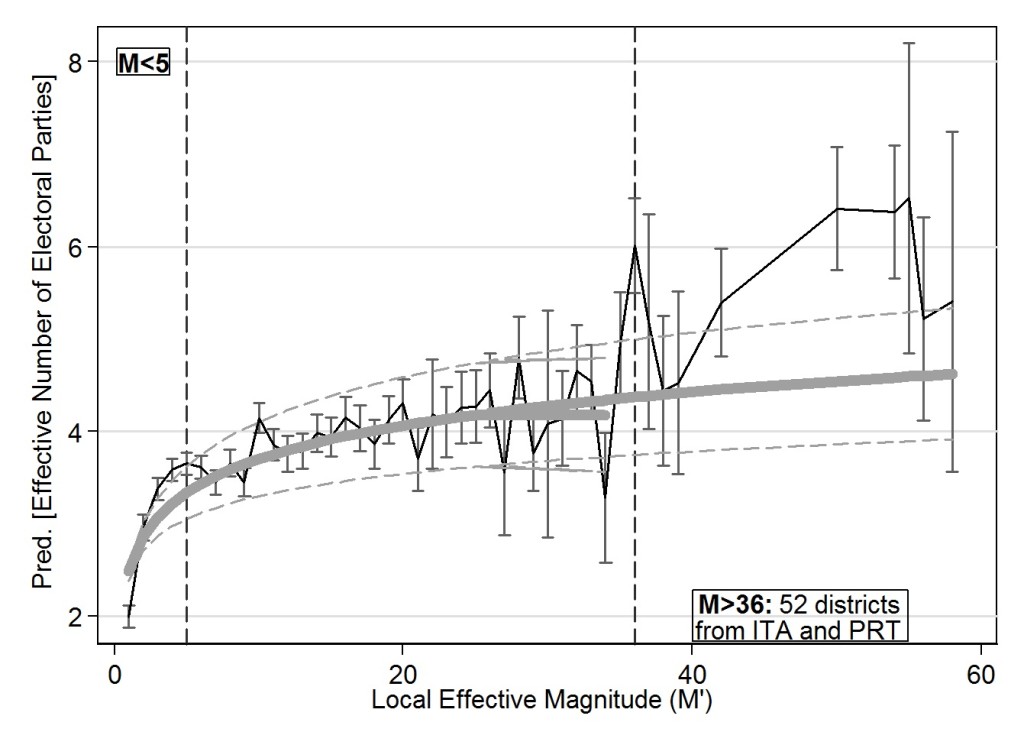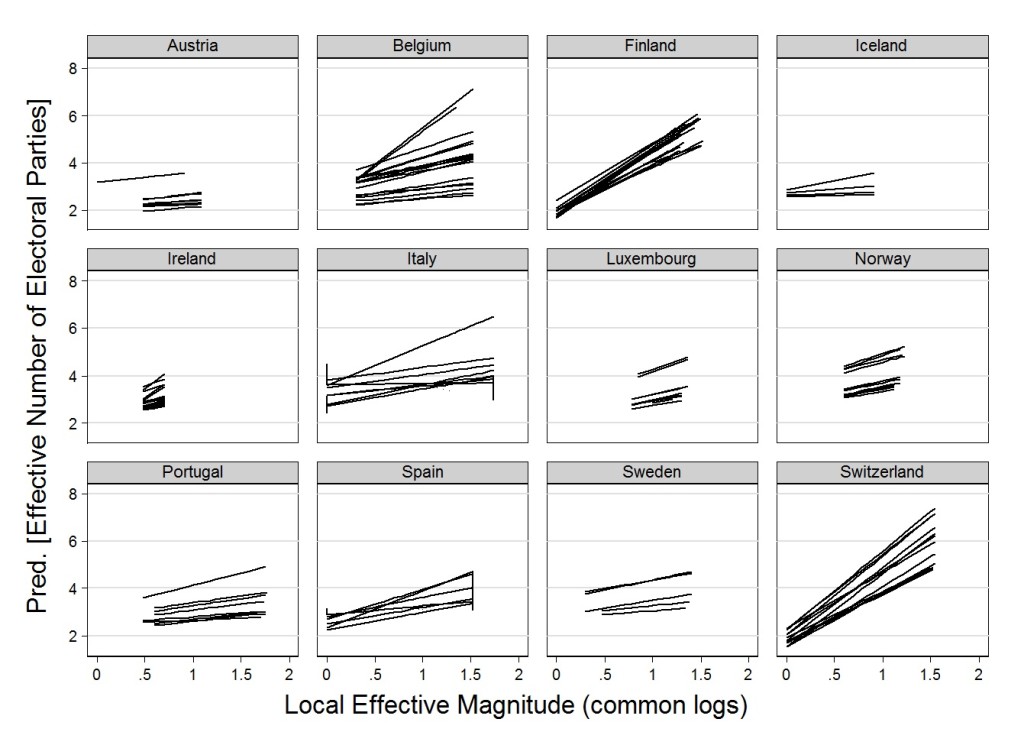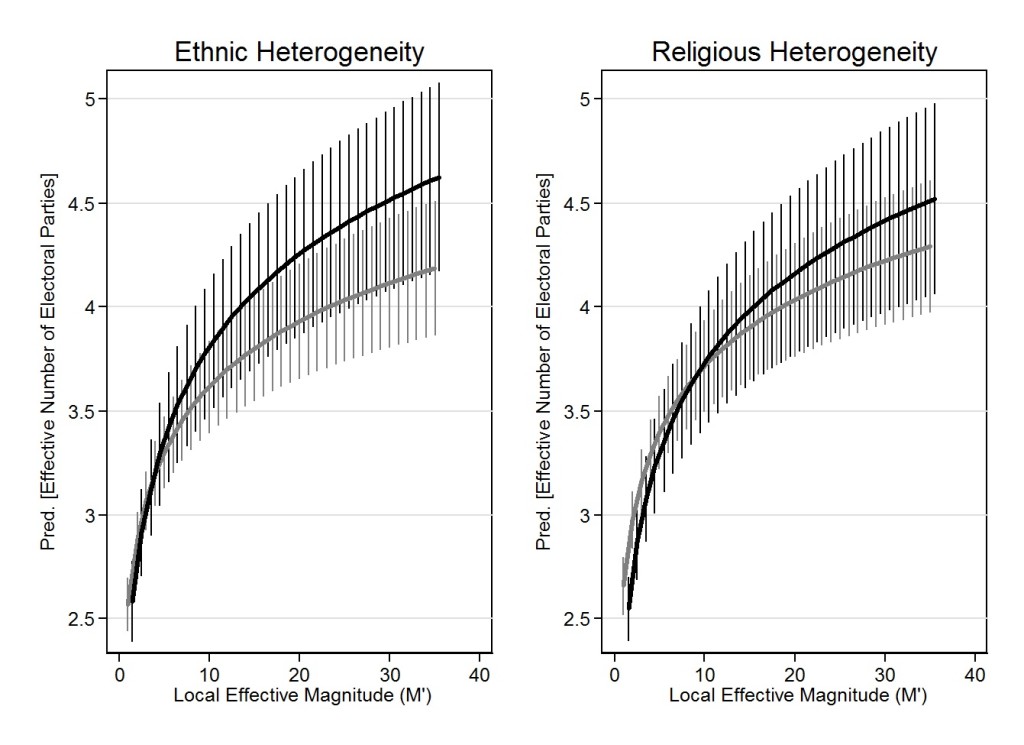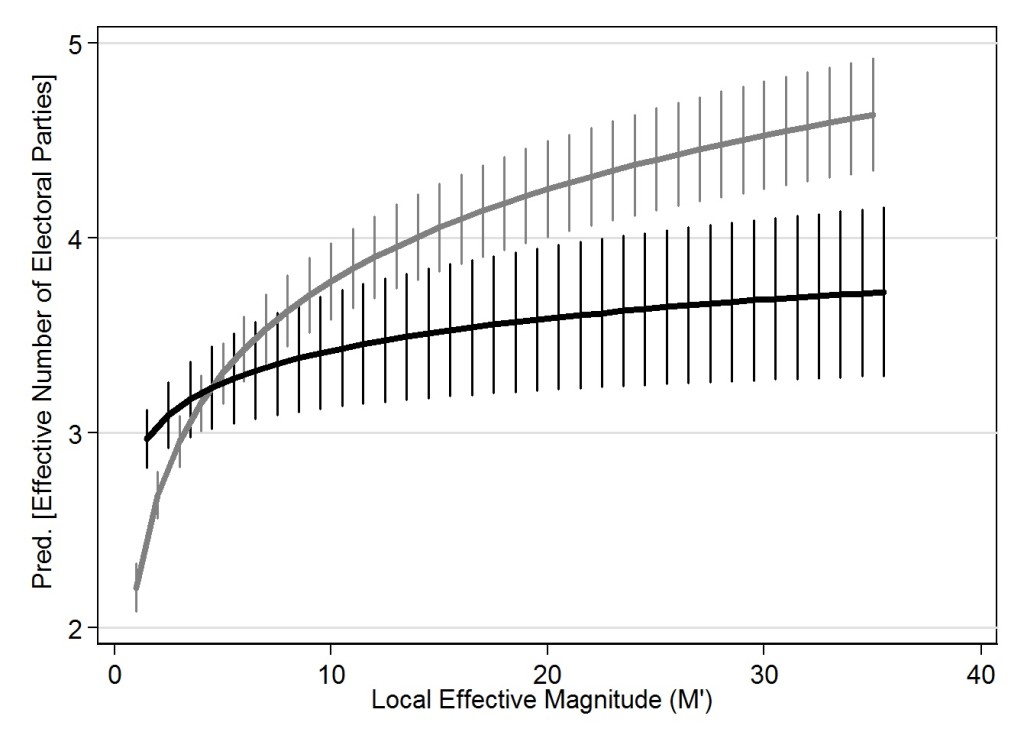Electoral systems are significant in determining the structure of electorates
Analysing a vast database of district level election results, Gudio Tiemann shows the political consequences of electoral systems at the district level, concentrating on the effects of (local) district magnitudes on the fragmentation of (local) electorates and the context-dependency of electoral system effects. The straightforward focus on the district level addresses where the causal forces behind Duverger’s law actually operate and exploit rich datasets that have only recently been made available for empirical analyses.
Bottom-Up: Providing the Societal Demand for Candidates or Political Parties
The sociological perspective has traced back the nature and number of candidates or political parties to the type and the number of substantial cleavages in a society. However, authors who suggest a more actor-centred perspective have contested these notions and, following Mancur Olson, has sharply criticized the apparent believe that social interests will somehow automatically organise in political parties for ignoring imminent collective action problems which may, among other sources, arise from the institutional context.
Top-Down: Limiting Party Proliferation and Establishing an Upper Bound
Gary W. Cox has picked up earlier arguments enshrined in “Duverger’s Law”. His formal modelling suggests that in each single member plurality district (M=1) there will be only two vote-getting candidates in a game-theoretic equilibrium. Subsequently, Cox extends his arguments to multi-member districts (M>1). He suggests that there may be no more than M+1 viable candidates in each district of the magnitude M. This proposition, labelled the “M+1 rule”, is the central building block of Cox’ contribution to the analysis of electoral systems. The formal statement does not imply any unconditional comparative statics of electoral systems, but in contrast conceptualises institutional constraints as erecting an upper limit or a carrying capacity for the number of viable candidates or lists in a game-theoretic equilibrium.
Single-Tier and Multi-Tier Districting
Whether these district magnitudes are actually binding depends on the district structure. In single-tier systems, when only “primary” districts are present, district magnitude as specified by the M+1 rule may be binding. Parliamentary seats can only be won and lost within each of the individual districts, and both voters and party elites need to react to the institutional incentives.
In contrast, if the primary districts are grouped into “secondary” districts, the impact of the M+1 rule might easily be watered down since voters and political elites might support lists or candidates which are out of the running in the primary districts in order to potentially win a seat in one of the secondary, upper-tier districts.
Data
There has often been an asymmetry of electoral system theories, which focused on the district level, and the availability of reliable empirical information that was regularly only accessible for the national level. One of the most exhaustive datasets has been published by Daniele Caramani (2000), who compiled systematic and standardized district-level general election results, where available, for 18 West European countries from as early as 1830 until the end of the twentieth century.
In this study, I draw heavily on this rich database, but I settle on the interval from 1945 to 1998 in order to obtain parallel, synchronous observations taken from as many countries as possible. In this period, detailed district level data is available for 169 elections to the respective national parliaments. Thus, the dataset comprises 17,248 electoral districts. This number includes 14,152 single-member districts in Germany, Italy, and the United Kingdom and 3,096 multi-member districts in Austria, Belgium, Finland, Iceland, Ireland, Italy, Luxembourg, the Netherlands, Norway, Portugal, Spain, Sweden, and Switzerland. The dataset has, where available, been carefully augmented by information on district magnitude, several other electoral system features and national-level information regarding social heterogeneity from a variety of sources.
The Empirics of Party Supply and Demand
I begin the presentation of the results with some simple bivariate evidence which does not straightforwardly relate to the M+1 rule, but rather adopts the inductive perspective embodied in the “generalized Duverger’s law”. Figure 1 summarizes these findings graphically and provides some additional checks on the association of the number of candidates or parties and its specific functional form: the thick line indicates the logarithmic mapping of effective magnitude upon the effective number of electoral parties, the thin dashed lines show the respective confidence intervals (all printed in grey).
The diagram displays another model so as to facilitate specification checks: instead of treating logged effective magnitude as a continuous predictor, I break district magnitude down into a series of dummy variables (1≤M≤58). The vertical error bars capture the effect of district magnitude on the effective number of parties and the related confidence intervals (all printed in black). Both specifications produce almost identical results, at least as long as district magnitudes are small.
Figure 2 explores the context dependency of electoral systems in more detail. The effect of local district magnitudes on the fragmentation of local electorates, as indicated by the random slope on logged effective magnitude, significantly varies by election and by country. Each of the lines captures predictions for the marginal effects of district magnitude. Flat regression profiles refer to the absence of electoral system effects and number of candidates or lists is about the same in small and in large districts. Steep profiles indicate that strong marginal effects and district magnitudes may potentially be binding. In this case, small district magnitudes are linked with low, and large magnitudes are linked with high numbers of electoral parties.
This allows us to shed some light on the political consequences of effective magnitude: In the first group of countries, there is a particularly steep slope indicating a significant marginal effect of local district magnitudes on electoral fragmentation. This is clearly visible in countries that are comparatively more heterogeneous in ethnic and religious terms and/or have implemented single-tier P.R. systems. Countries like Finland, Ireland, and Switzerland and, somewhat less clearly, Portugal and Spain fall into that category.
The second cluster of countries also unambiguously reveals significant marginal effects, but these are somewhat weaker or unstable across repeated elections: Belgium, Italy, and Luxembourg.
In a final cluster of countries, there is only limited evidence for the marginal effects of district magnitude. Almost flat predictions for the election-specific regression profiles indicate that institutional incentives are obviously not effective and/or binding. This refers to countries which are either socially homogeneous and/or have implemented more complicated P.R. electoral systems with upper tiers and vote or seat transfers such as Austria, Iceland, Norway, or Sweden.
When evaluating whether district magnitude becomes binding, the analytical scope cannot be limited to the supply side given by the electoral system, but also needs to consider the demand side given by the number of societal groups, which organize into political parties and strive for representation in parliament. An extensive database on ethnic and religious fragmentation provides the principal indicators for social heterogeneity.
Figure 3 provides evidence in favour of the joint supply and demand model and displays the predictions derived from the multilevel models. Regarding ethnic (the left-hand panel) and religious diversity (the right-hand panel), the marginal effects of district magnitude are substantively stronger in heterogeneous than in homogeneous countries. The marginal effect of ethnic heterogeneity seems to be somewhat more meaningful and robust than the consequences of religious diversity. These arguments conform to the analytical concept of the M+1 rule in a more straightforward manner. Effective magnitude becomes binding when there is a high number of groups forming parties and contesting the elections; in contrast, the marginal effects of district magnitude are much weaker in more homogeneous countries where the proliferation of candidates or parties will often be below the carrying capacity established by the electoral rules from the outset.
The Effects of Upper Tiers
The provision of upper tiers may render local district magnitudes less binding and the M+1 rule less applicable or invalid. Figure 4 illustrates the model predictions. Controlling for social heterogeneity, the number of candidates or lists visibly increases with district magnitudes if there are only primary electoral districts, and local district magnitudes thus tend to be binding. In contrast, the effects of district magnitude almost completely diminish when we focus on those electoral systems that do employ secondary (or even tertiary) districts. In the presence of upper tiers, the local number of candidates or parties in small and in large districts is almost the same.
Summary and Conclusion
Any generalisation of a well-established hypothesis, most notably the proposition of a “Law”, suggests the very impression of scientific progress. While the strategy of gross national-level generalisation seems to be exhausted and does not provide any new insight, sophisticated research based on district-level data, for instance the growing literature on mixed-member electoral systems, is too often confined to single-case studies yielding heavily context-dependent results and almost no scope for systematic generalization.
The empirical results underscore both the significance of electoral systems for the structure of (local) electorates and their profound context-dependency:
(1) district magnitude only becomes binding when a high social demand meets a low carrying capacity of the electoral district;(2) the magnitude of primary electoral districts only tends to be binding when the electoral structure provides no upper tiers or allocates only a very limited share of seats in the upper tiers.
—
To see the West European Politics journal blog that this piece is based on, click here.
Note: This post represents the views of the author and not Democratic Audit or the LSE. Please read our comments policy before posting.
—
- Guido Tiemann is Assistant Professor of Comparative European Politics, Institute for Advanced Studies Vienna











 Democratic Audit's core funding is provided by the Joseph Rowntree Charitable Trust. Additional funding is provided by the London School of Economics.
Democratic Audit's core funding is provided by the Joseph Rowntree Charitable Trust. Additional funding is provided by the London School of Economics.
Electoral systems are significant in determining the structure of electorates https://t.co/75MgK5hcdK
Electoral systems are significant in determining the structure of electorates https://t.co/T7fTdhefGG #Option2Spoil